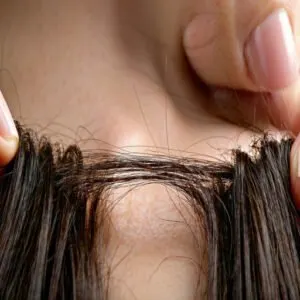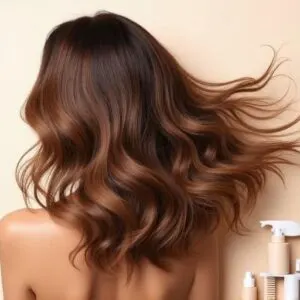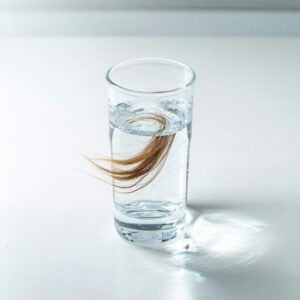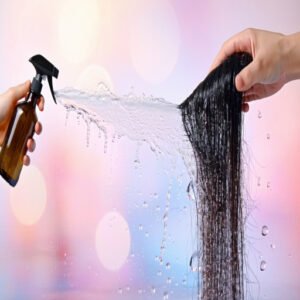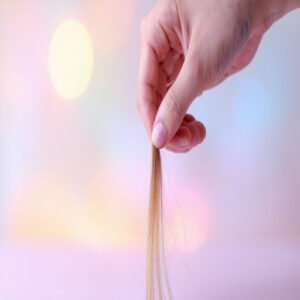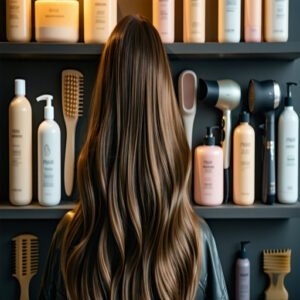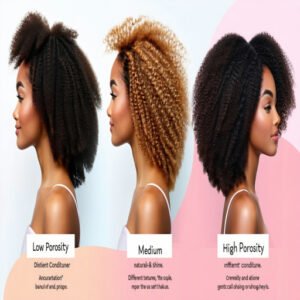This site is supported by our readers. We may earn a commission, at no cost to you, if you purchase through links.
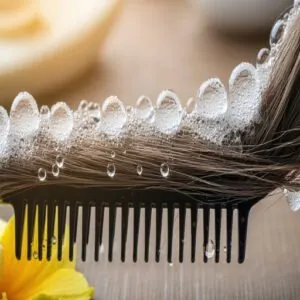
Like a sponge, your hair’s outer layer (the cuticle) can be tightly sealed or more open to moisture.
Hair porosity isn’t just a fancy term; it’s the key to understanding why your hair might drink up products like a camel in the desert or repel moisture like a raincoat.
It’s determined by your cuticle structure, which acts as your hair’s bouncer, controlling what gets in and what stays out.
Understanding your hair’s porosity level reveals the secret to choosing the right products and techniques.
Table Of Contents
- Key Takeaways
- Hair Porosity Defined
- What is Hair Porosity
- Hair Porosity Levels
- Measuring Hair Porosity
- Hair Porosity and Damage
- Caring for Hair Porosity
- Hair Porosity and Hair Care
- Frequently Asked Questions (FAQs)
- Is it better to have high or low porosity hair?
- How do you know your hair porosity?
- Which porosity is good for hair?
- How do you fix hair porosity?
- Can mixed porosity hair exist on one head?
- Does hair porosity change with age or hormones?
- How often should porosity tests be performed?
- Can medications affect your hairs porosity level?
- Does climate or weather impact hair porosity?
- Conclusion
Key Takeaways
- Your hair’s porosity level refers to its ability to absorb and retain moisture, which is determined by the structure of your hair’s outer layer (cuticle)
-understanding this helps you choose the right products and care routine
- You can determine your hair’s porosity level through simple tests: the glass of water test (sinking = high porosity, floating = low porosity), the spray test (how quickly water absorbs), or the cuticle test (smooth = low porosity, rough = high porosity)
- Heat styling, chemical treatments, and harsh products can damage your hair’s cuticle layer and increase its porosity over time, leading to moisture loss and breakage – so you’ll need to adjust your care routine accordingly
- Different porosity levels require different care approaches: low porosity hair needs lightweight products and heat to help absorption, medium porosity hair maintains moisture naturally and works well with most products, while high porosity hair requires protein-rich treatments and leave-in conditioners to lock in moisture
Hair Porosity Defined
Hair porosity refers to your hair’s ability to absorb and retain moisture, which is determined by the structure of its outer layer, the cuticle.
Understanding this concept helps you choose the right products and techniques to keep your hair healthy and balanced.
Hair Structure and Composition
Hair structure defines your hair’s overall strength and elasticity.
It’s made up of three layers:
- Cuticle: The outer, protective shield, essential for retaining moisture and resisting damage.
- Cortex: The thick middle layer, responsible for fiber strength, color, and flexibility.
- Medulla: The soft core, more common in thicker hair.
Together, these layers affect density, hair cuticle structure, and how hair behaves daily.
Role of Cuticle Layer
The cuticle layer plays a pivotal role in controlling hair porosity.
Acting as a moisture barrier, its layered structure protects the inner hair shaft while influencing flexibility.
When the cuticle is smooth and intact, it resists moisture, regulating porosity control.
However, lifted or damaged cuticle layers allow water to flood in and escape, compromising overall hair strength and flexibility.
Understanding cuticle function helps maintain balanced moisture.
Importance of Moisture Absorption
Think of your hair like a sponge—it needs the right balance of moisture to stay soft and strong.
Moisture absorption depends on hair porosity, which dictates how easily water moves in and out. Understanding hair porosity is essential for determining the best hair care routine.
Without proper moisture levels, porous strands may feel dry or brittle. Understanding hair moisture levels helps you customize hydration methods, creating healthy hair hydration while maintaining balanced moisture levels for low porosity hair.
What is Hair Porosity
Understanding hair porosity means knowing how well your hair absorbs and retains moisture.
It’s not about hair texture but about how your cuticles function. Porosity tests, like the water or spray tests, help you figure out your hair’s moisture balance needs.
If you’ve ever struggled with dryness or frizz, the issue might stem from your hair porosity. Knowing your hair porosity level is essential for choosing the right hair care products and treatments.
- Low porosity has tightly packed cuticles, resisting moisture.
- Medium porosity balances moisture absorption and loss.
- High porosity absorbs quickly but struggles to retain hydration.
Hair Porosity Levels
Hair porosity levels describe how well your hair absorbs and retains moisture, and they fall into three categories: low, medium, and high.
Each level has unique traits that influence your hair’s needs and care routine.
Low Porosity Hair Characteristics
Compared to high porosity, low porosity hair can feel resistant to moisture, reflecting distinct differences in cuticle health.
Strands take longer to dry and may struggle with hydration or product buildup, leaving hair brittle.
Understanding low porosity characteristics is essential for effective hair care.
Maintaining proper moisture levels and elasticity requires lightweight products, like water-based conditioners.
These adapt best to the dense cuticle and protein needs of low porosity hair.
Medium Porosity Hair Traits
Medium porosity hair strikes a balance between moisture absorption and retention, giving it great elasticity and bounce.
These traits of medium porosity make it easier to manage, as it responds well to most products.
Your hair’s cuticle lets moisture in without causing over-drying or breakage, and a daily routine focusing on hair nutrition can help maintain a healthy moisture balance. Regular porosity tests can also contribute to this balance.
High Porosity Hair Features
High porosity hair often struggles with moisture balance due to cuticle damage and raised cuticles.
This leads to rapid moisture absorption and loss, causing dryness and hair breakage. Understanding these features helps with proper care.
Key characteristics of high porosity hair include:
- Frizz-prone due to open cuticles
- Weak hair elasticity, leading to snapping
- Quick absorption of oils and water
- Needs porosity repair for smoothness
Measuring Hair Porosity
You can measure hair porosity using simple methods like the glass of water test, spray test, or cuticle test.
These techniques help you understand how well your hair absorbs and retains moisture.
Glass of Water Test
Curious about your hair’s moisture game? The glass of water test simplifies strand analysis.
Wash your hair, drop a strand into water, and observe the results. If it sinks, you’ve got high porosity; floats in the middle, it’s medium; stays on top, it’s low.
Understanding your hair porosity test is essential for choosing the right products to improve hair health. This float method reveals porosity levels, highlighting how buoyancy impacts absorption and product needs.
Spray Test Method
Ready to try another hair porosity test? The spray test method offers a quick way to understand your hair’s relationship with water.
Simply spritz clean, dry hair with water and watch how it reacts.
- Water sitting on top indicates low porosity
- Quick absorption points to high porosity
- Moderate absorption suggests medium porosity
- Uneven absorption might signal varying porosity levels
- Multiple strands give more accurate results
Your hair’s reaction to the water droplets reveals its porosity nature!
Cuticle Test Technique
The cuticle test gives you a hands-on way to check your hair porosity.
Run your finger along a strand of hair – if it feels smooth and glides easily, you’ve likely got low porosity hair.
High porosity strands will feel bumpy or rough to the touch.
This finger test works best on clean, dry hair for the most accurate hair analysis and porosity check.
Hair Porosity and Damage
You’ll find that your daily hair care habits, including heat styling and chemical treatments, can substantially change your hair’s porosity level over time.
While genetics determines your natural hair porosity, using harsh products or excessive heat can damage your hair’s protective cuticle layer, making it more porous and prone to moisture loss.
Effects of Heat Styling
After checking your hair porosity, you’ll want to watch out for heat styling’s sneaky effects.
Your favorite hot tools can dramatically increase hair porosity by cracking those protective cuticles.
When you’re consistently using flat irons or curling wands at high temps, you’re not just styling – you’re potentially stripping natural oils, causing moisture loss, and even fading your hair color.
These changes can lead to persistent dryness and breakage.
Chemical Treatment Impact
Chemical treatments can dramatically alter your hair’s porosity, often leading to increased vulnerability and damage.
Whether you’re coloring, relaxing, or perming your hair, these processes can impact its structure in several ways.
The following effects can occur as a result of chemical treatments:
- Chemical damage weakens the protective cuticle layer
- Color treatments can cause significant texture changes
- Frequent processing leads to increased porosity shifts
- Bleaching treatments make hair more susceptible to breakage
Harsh Product Consequences
Using harsh products can wreak havoc on your hair’s natural balance.
Regular use of sulfate-heavy shampoos and alcohol-based styling products often leads to hair breakage and increased porosity.
Understanding hair porosity is essential to recognizing how these products affect your hair’s ability to absorb moisture.
You might notice scalp irritation, chemical burns, or follicle stress from these aggressive formulas.
What’s worse, this product damage can transform healthy hair into high porosity strands, making it harder to retain moisture and maintain strength.
Caring for Hair Porosity
You’ll need different care methods for your hair based on its porosity level, which determines how well it absorbs and holds moisture.
Whether you have low, medium, or high porosity hair, you can maintain healthy locks by choosing the right products and following specific care techniques that work for your hair’s unique needs.
Low Porosity Hair Care Tips
Wondering why your hair seems resistant to moisture? If products sit on top instead of sinking in, you’ve got low porosity hair.
To keep your strands happy, apply products to wet hair and use heat to help them penetrate better. Understanding low porosity hair care is essential for effective hair management.
Skip heavy oils and opt for glycerin-rich hair masks instead. Gentle shampoos without residue and diluted conditioners will be your best friends for moisture locking success, and for more information, check low porosity hair care.
Medium Porosity Hair Maintenance
Medium porosity hair is like hitting the sweet spot in your daily hair routine – it maintains moisture balance naturally and responds well to most products.
You’ll want to keep up this goldilocks zone with gentle shampooing twice weekly and a monthly hair oil treatment.
Focus on maintaining protein intake through regular conditioning, and you’ll find your hair care routine stays pretty manageable with minimal fuss.
High Porosity Hair Restoration
Transform your high porosity hair from thirsty to thriving with targeted restoration techniques.
Your strands need extra care to lock in moisture and maintain strength.
Using a leave in conditioner can greatly improve hair manageability.
- Apply leave-in conditioners rich in protein to rebuild damaged areas
- Layer lightweight oils to seal moisture without weighing hair down
- Deep condition weekly with heat to maximize absorption
- Use silicone-free products to prevent moisture-blocking buildup
Hair Porosity and Hair Care
You’ll find that understanding your hair’s porosity level can transform your entire hair care routine, helping you select the right products and techniques for your specific needs.
Once you’ve identified your hair’s hair care approach, you can customize your hair care approach with the proper moisturizing methods and product applications that work best for your hair structure.
Choosing Right Hair Products
Your journey to healthier hair starts with understanding product ingredients for your porosity level.
Here’s a thorough guide: For individuals with low porosity hair, using low porosity products can substantially improve hair health.
| Hair Porosity | Recommended Products | Key Ingredients | Oil Benefits | Frequency |
|---|---|---|---|---|
| Low | Lightweight serums | Glycerin, aloe | Grapeseed oil | Weekly |
| Medium | Balanced formulas | Honey, shea | Jojoba oil | Bi-weekly |
| High | Rich conditioners | Keratin, proteins | Castor oil | Daily |
| Combination | Mixed products | Varied blends | Multiple oils | As needed |
| Damaged | Repair treatments | Amino acids | Olive oil | Bi-weekly |
Customizing Hair Routine
A well-crafted hair routine starts with understanding your hair porosity type.
If you’ve got low porosity hair, focus on lightweight products and steam treatments. Medium porosity hair thrives with balanced moisture products, while high porosity hair needs heavier creams and protein-rich formulas.
Adjust your styling options and product selection based on how your strands respond, making routine adjustments as needed, focusing on the right approach for your specific hair porosity.
Achieving Healthy Hair Balance
Maintaining hair’s natural moisture balance requires understanding your unique hair porosity level.
When you align your hair care routine with proper Hair Nutrition and Scalp Health, you’ll notice improved Hair Elasticity and Hair Resilience.
Whether you’ve got low, medium, or high porosity hair, focus on consistent hydration methods that work for your strands.
Remember, healthy hair isn’t about perfect porosity—it’s about finding what keeps your locks happy.
Frequently Asked Questions (FAQs)
Is it better to have high or low porosity hair?
Like apples and oranges, neither high nor low porosity is "better."
They’re just different ways your hair manages moisture.
What matters is understanding your hair’s needs and using the right products accordingly.
How do you know your hair porosity?
Try the simple float test: drop a clean hair strand in water.
If it sinks quickly, you’ve got high porosity.
Stays in the middle? Medium porosity.
Floats on top? That’s low porosity hair.
Which porosity is good for hair?
At the end of the day, medium porosity is considered ideal as it strikes the perfect balance.
Your hair can readily absorb moisture while maintaining it effectively.
Don’t stress if you’ve got different porosity.
How do you fix hair porosity?
Balance your hair’s porosity by using protein treatments for high porosity or lightweight oils for low porosity hair.
Deep condition regularly, avoid heat damage, and seal moisture with cold water rinses after washing.
Can mixed porosity hair exist on one head?
Picture Sarah’s hair: straight at the roots with medium porosity, yet her chemically treated ends show high porosity.
Yes, you can have different porosity levels on one head due to damage, treatments, or genetics.
Does hair porosity change with age or hormones?
Yes, your hair porosity can change as you age or experience hormonal shifts.
These changes often come from aging’s natural effects on hair structure and hormonal fluctuations during pregnancy, menopause, or medical treatments, which can impact your hormonal balance.
How often should porosity tests be performed?
Test your hair’s porosity every 3-4 months, or when you notice changes in texture or moisture absorption.
If you’ve recently used chemical treatments or heat styling frequently, you’ll want to check more often.
Can medications affect your hairs porosity level?
Medications, especially those affecting hormone levels or causing hair loss, can change your hair’s porosity.
Common culprits include birth control, thyroid medications, and chemotherapy drugs.
Consider checking your porosity after starting new prescriptions.
Does climate or weather impact hair porosity?
Yes, weather conditions can affect your hair’s porosity.
High humidity makes your strands absorb more moisture, while dry, cold climates can leave them dehydrated.
Environmental factors like sun exposure also impact moisture retention.
Conclusion
Like a master key that opens your hair’s full potential, understanding hair porosity empowers you to make smarter choices for your strands.
Armed with knowledge about what’s hair porosity and how it affects your hair’s behavior, you’re better equipped to select the right products and techniques.
Remember, your hair’s unique porosity level isn’t good or bad – it’s simply a characteristic that guides your hair care journey toward healthier, more manageable locks.
- https://www.clevercurl.com.au/how-to-determine-hair-porosity-and-what-it-means-for-your-hair/
- https://www.healthline.com/health/hair-porosity
- https://curlsmith.com/blogs/curl-academy/hair-porosity-guide
- https://www.carolsdaughter.com/blog/hair/hair-care-tips/hair-porosity-low-and-high.html
- https://nyscc.org/blog/an-overview-on-hair-porosity/


